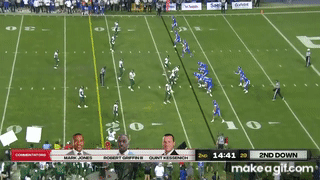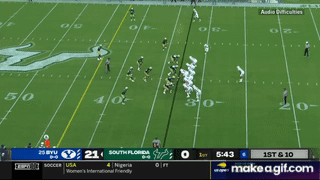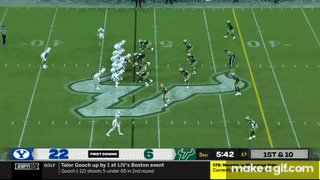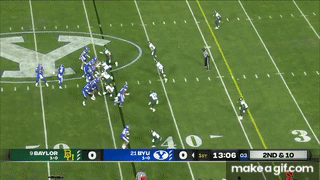The Hogs are looking to right the ship on Saturday in Provo. The road trip continues Arkansas’ weirdly-difficult 2022 non-conference schedule. Kalani Sitake’s BYU team is 4-2 and has already beaten Baylor within the friendly confines of LaVell Edwards Stadium in the beautiful Wasatch Mountains. The Cougars are in their final season of independence before they join the Big 12 next year.
Our coverage this week has already introduced BYU, including its rich football history under LaVell Edwards, and, in a bit of historical trivia, the infamous historical event that ties Arkansans and Brigham Young. Let’s hope that when this large group from Northwest Arkansas travels to Utah and encounters Brigham Young, it ends better than it did in 1857.
Meet the Cougars
Confused by any of the advanced stats you see here? Be sure to check out the glossary.

These two teams are pretty even, with the Hogs about 2 points better on a neutral field. The big number is the very last one: after hot starts, both squads are trending in the wrong direction. So the loser of this game will be truly disappointed in their season, while the winner still has a chance to recover.
Scouting Report
The BYU offense creates a ton of explosive plays and rarely turns the ball over. That makes them a tough matchup for a Razorback defense that’s been torched by big plays. The good news for the Hogs is that the Cougars are not overly efficient, not very physical in the trenches, and not very good if knocked off-schedule. If the defense can keep the lid on big plays, the pass rush has a chance to save the day.
The defense is exactly what this Razorback offense wants to see. The Cougars have some similarities to South Carolina in that they are very vulnerable to power running games. Opponents have been lining up and running it down their throats all year.
Names to Know
- Jaren Hall. BYU’s quarterback has thrown for more than 4,000 yards and 30 touchdowns in his career. He’s a bit banged up, but if he has time to throw and his shoulder feels fine, he’ll probably light up the Razorback secondary.
- Ben Bywater. The Cougars’ top tackler is one of its inside linebackers. Bywater has also picked off two passes this season. He’s primarily a run defender.
- Max Tooley. The undersized outside linebacker has picked off three passes and is second on the team in tackles. He’ll defend tight ends and backs in coverage.
When BYU has the ball
The Cougar offense is key to its success, and BYU is well-equipped to win a shootout.

This will be a difficult matchup because BYU is well-equipped to exploit Arkansas’ issues with big plays. Explosive offenses are often vulnerable to turnovers, but not BYU. The main thing holding the Cougars back is a lack of an efficient run game and struggles in the red zone. If this game does turn into a shootout (and there’s a good chance of that), then the bad red zone offenses of both of these teams could end up taking center stage.
The Wide Zone Offense
BYU runs a simplified, college-friendly version of the offensive scheme currently taking the NFL by storm: the wide zone. The wide zone starts with former NFL head coach Mike Shanahan, who mixed West Coast passing principles with a zone run scheme. Shanahan himself was only moderately successful, but his former assistants are now all over the NFL, namely Sean McVay of the Rams, Kyle Shanahan of the 49ers, Matt LaFleur of the Packers, and Zac Taylor of the Bengals. Among SEC teams, BYU’s offense is most similar to Kentucky’s, as the Wildcats hired a former McVay assistant as their offensive coordinator a couple years ago.
The wide zone is built around a single base run play: outside zone.

The Cougars will run this out of 11p (1RB, 1TE, 3WR – the Rams’ system) and 12p (1RB, 2TE, 2WR – the 49ers’ system). They’ll run it out of shotgun and under center. They’ll run it with a backside h-back kicking out the end. They’ll run it from several different formations and alignments. They’ll run it with all kinds of at-snap motion. It’s all outside zone.
Outside zone is particularly dangerous because it stretches the defense horizontally. If BYU is ever able to establish it, a ton of other stuff in their playbook becomes available. This fits well with a West Coast passing attack, which also is known for its horizontal stretches.
First, the Cougars can keep running. Stopping outside zone requires tremendous pursuit, but if defenders overpursue, jet motion back against the zone direction can be devastating:

South Florida defends this one well, but later, the Cougars run split zone with jet motion:

As we’ll see in the stats below, a lot of BYU’s run plays don’t go anywhere, but they break huge runs on a regular basis because they are constantly scheming opposing linebackers out of plays. The Razorback defense will have to cover the entire field sideline to sideline against this run game and a single breakdown can be a touchdown.

You can see the standard downs explosiveness, which is what their offense is predicated on. Note also that high pass rate on standard downs. They come out throwing because their run game isn’t very efficient, so short, safe passes keep the offense on-schedule until they can break a big run play. That’s really the basic strategy for this offense.
Outside zone sets up play-action really well because it gets the quarterback on the move. BYU will throw out of play-action a ton:

These early-down passes are the chain-movers and are generally very efficient. When forced to pass, the Cougars aren’t quite as strong, ranking just 65th in passing downs success rate and 72nd in marginal third down conversion rate. So there’s some risk to the offense: if they can’t generate those explosive run plays, many of their drives will run out of gas well short of the end zone.

Look at those run numbers! The Cougars are 109th in rushing success rate and only get 6-plus yards on 27% of their carries (96th)… but those 27% of carries tend to go for huge gains. All their run game is good for is generating explosive plays.
The dropback passing game has a lot of traditional West Coast elements: slants, hitches, quick outs. A lot of short and timing routes. They’ll take deep shots on occasion and are mediocre at hitting them. Quarterback Jaren Hall has thrown just two interceptions in 188 attempts this season, with 14 touchdowns.
Injuries
Injuries could play a big factor in this game. Hall is battling a shoulder injury, and while he played against Notre Dame, he threw just 17 passes and was clearly favoring his right shoulder. Sitake said “he’s gotta go… he’s got no choice”, which doesn’t exactly inspire confidence.
The Cougars are also unsure about the status of Gunnar Romney. Expected to be the team’s top receiver, Romney missed the first four games with a lacerated kidney, returned and had four catches against Utah State, and then suffered some kind of kidney-related re-injury against Notre Dame. He actually went to a hospital, but that appears to have been extreme precaution. Sitake says he expects Romney to play.
Last but not least is Miles Davis. A co-starter at running back, Davis has 24 carries for 167 yards this season, leading the team in yards per rush (7.2), EPA per rush (+0.11), and bonus yards per explosive run (15.1). Most of his season stats came against Wyoming, where he had 13 carries for 131 yards. He suffered an injury against Utah State and didn’t play last week. His status is unknown. Lead back Christopher Brooks is healthy.
These BYU injuries likely contributed to the betting line moving more towards the Razorbacks.
For Arkansas’ defense, everything is unknown for the three major secondary injuries: Myles Slusher, Khari Johnson, and Jayden Johnson. Slusher didn’t travel to Starkville after injuring his calf at some point during or before the Alabama game. His current injury is unrelated to the scary injury he suffered in the opener against Cincinnati. The two Johnsons were both knocked out of the Mississippi State game with undisclosed injuries. Neither practiced at the start of the week, but that doesn’t necessarily mean they won’t play Saturday. Per Andrew Hutchinson, the Razorbacks appear to have moved a second receiver into the defensive backfield, as freshman Quincy McAdoo was seen working out with defensive backs, a week after fellow freshman Sam Mbake made a similar move. I would expect both to be back at receiver in the spring.
When Arkansas has the ball
With KJ Jefferson back, the Hogs need to get back to what’s working for them. Given the state of the defense, Kendal Briles and his unit have to plan for a shootout in every game from here on in.

The Hogs have morphed into a Bret Bielema offense this year, using high efficiency (13th) and low explosiveness (89th) to sustain long drives (33rd) and lean on the offensive line. The Razorbacks aren’t good at finishing those drives (71st), which is really the only major knock against them.
After years of base 3-man fronts that struggled to stop the run, BYU has mostly run a 4-2-5 this season. So far, it hasn’t helped much. The Cougars struggle to get off the field, surrendering a lot of yards (99th in available yards), a lot of plays (103rd), and a lot of efficiency (84th). They do manage to keep the lid on explosive plays (39th) and tighten up in the scoring zone (44th).
Their inability to get off the field has hurt their offense: the Cougars ran just 46 plays and held the ball for just 19 minutes against Notre Dame.

BYU’s defense is very similar to South Carolina’s: opponents are extremely run-heavy against them, and they struggle to disrupt that. Opponents are running on 64% of standard downs, and generating +0.08 EPA per standard downs snap (92nd). The Cougars are 96th in leverage rate and 105th in havoc rate, so they struggle to knock run games off-schedule. And while they are stronger on passing downs, they aren’t great at getting off the field on third down (102nd).

The Cougars tackle well and fit well against the run, they just make too many tackles well past the line of scrimmage. They’re 109th in stuff rate and 106th in line yards per rush, which is the source of their problems. Big runs are hard to come by, but the Hogs can win this game without generating a lot of huge runs.
Through the air, the Hogs have another opportunity to finally hit some big plays. Malik Hornsby pulled it off against Mississippi State, but KJ Jefferson hasn’t hit as many as he did last year, for reasons we discussed in the Mississippi State matchup analysis. The Hogs may can win this game without a ton of big plays (as against South Carolina), but they will need to pass with high efficiency and be good on third downs and in the red zone in order to do so. Basically, the margin for error will be smaller, as it has been all season.
On special teams
We don’t usually dedicate a full section to special teams, but it might be relevant for this game.
It sounds like Arkansas is going with Reid Bauer at punter moving forward, which is a welcome change that is only a few games too late. Bauer looked much better than Max Fletcher after replacing him last week.
For BYU, field goals have been an issue, which has contributed to their poor points per scoring opportunity. The Cougars as a team are 6 for 11 on field goals, with all five misses coming from inside of 40. They’ve made just one field goal try from beyond 40 yards. Keep an eye on that if the game comes down to the wire.
Keys to the Game
Clamp down on big run plays. This is the single biggest key. BYU will use a combination of short, safe throws and horizontal running to scheme defenders out of position. Then when one guy misses his run fit, the Cougars hit a home run on the ground. Edge defenders need to set the edge, and linebackers need to flow to the run and get their fits. Outside zones allow for cutback lanes as well, so the backside defenders have to be ready to tackle in space.
Get after the quarterback. Rushing the passer is all Arkansas does well at this point, but that could be enough if the Hogs do decently on the first key and then get a good rush. With the BYU quarterback battling injuries, the pass rush can tank the Cougars’ passing game before they can torch Arkansas’ vulnerable secondary.
Bounce back when you fall behind the sticks. The gameplan on offense will be like the South Carolina game: run the ball right down their throats. BYU will struggle to knock the Hogs’ downhill run game off-schedule, but that leaves a razor-thin margin for error, where any penalty, fumbled/bad snap, or blown play can put the offense behind the sticks. When that happens – whether its second-and-long or third-and-medium – the Hogs need good playcalling and execution to keep the drive alive.
Thanks for reading! Be sure to follow us on Twitter.
The latest from Fayette Villains, straight to your inbox
Enter your email to subscribe and receive new post alerts and other updates. You can unsubscribe at any time.